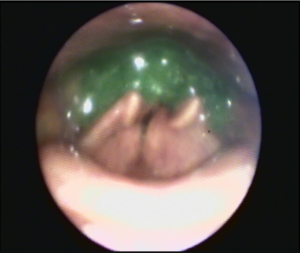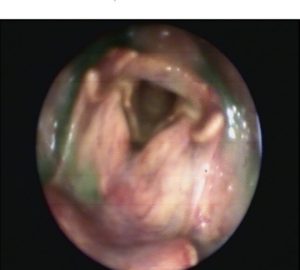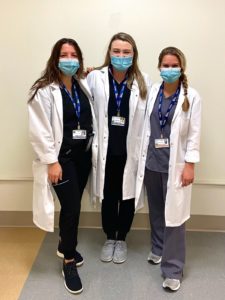FEES testing (Flexible endoscopic evaluation of the swallow) testing has been a fantastic tool to help diagnose dysphagia. FEES is used in a variety of settings. We have used this tool to recommend the appropriate food and fluid consistency in literally thousands of patients in the SNF setting over the years. We use FEES to assess the appropriate need for postural changes as well as the effectiveness of several compensatory strategies.
The following is an example of a less scientific single-study subject example of the effectiveness of treatment for a patient with severe dysphagia.
TC is an 83-year-old male who presented with TIA, COPD, pneumonia, dysphagia, asthma, and A-fib. Upon his arrival to a skilled nursing facility, a bedside swallow evaluation was conducted. TC was placed on pureed foods with honey liquids. The treatment plan for TC was five days a week dysphagia treatment with goals to increase strength and tone.
Initial FEES testing was conducted to rule out aspiration and assess for a possible diet upgrade. That test noted significant aspiration of both foods and fluids with pooling of residue to bi-lateral pyriforms. The picture below shows the severity of TC’s dysphagia. The green that you see is food and fluid dyed for easier visibility.

Working in collaboration with the treating clinician, who was present for the study, a new treatment plan was decided upon. It included increasing pharyngeal strength and tone and the use of NEMS as a treatment modality to increase laryngeal elevation. A follow-up study was scheduled for four weeks to assess any progress.

Four weeks later, the follow-up study was performed, and the results were clear and evident. Significant progress was evident with increased strength and tone noted. Pharyngeal squeeze was notably more pronounced after four weeks and as the picture below shows residue was significantly decreased.
TC was upgraded to a mechanical soft and nectar consistency and is continuing to work with the clinician to increase safe PO intake and increase the diet to regular and thin liquids.
This was one, albeit an outstanding, example of a great clinician dedicated to increasing the quality of life of her patients. We were just lucky enough to be apart of the care and capture it with a camera. Having these cases documented allows clinicians to see the progress that is made and allows clinicians to feel comfortable in advancing the patient’s diet while mitigating the risk of aspiration pneumonia, and potential re-hospitalization.
Want to learn more about FEES testing in the SNF setting? Want to chat about Speech Therapy, Rehab, or perhaps something else? I’d love to hear from you!


